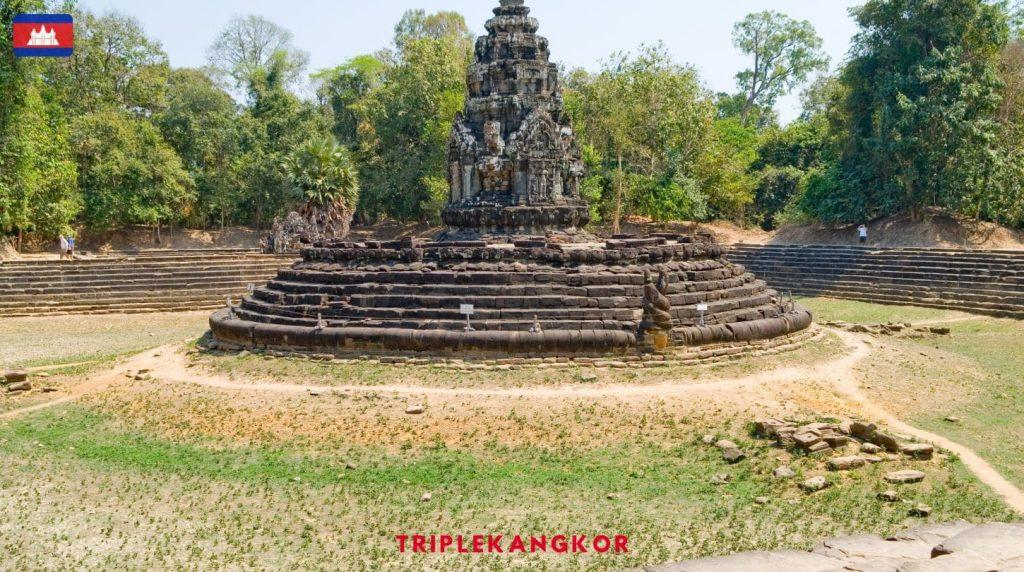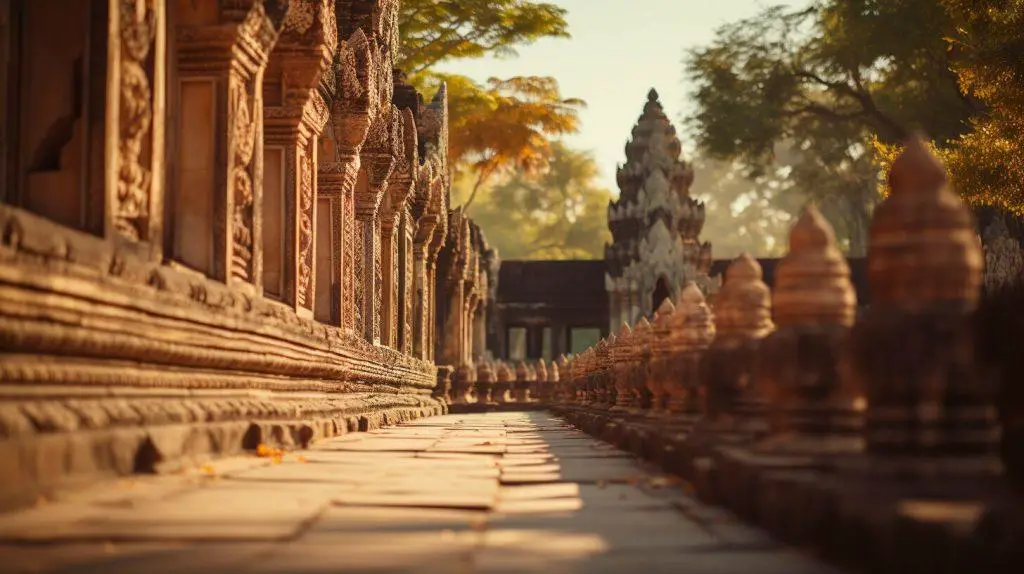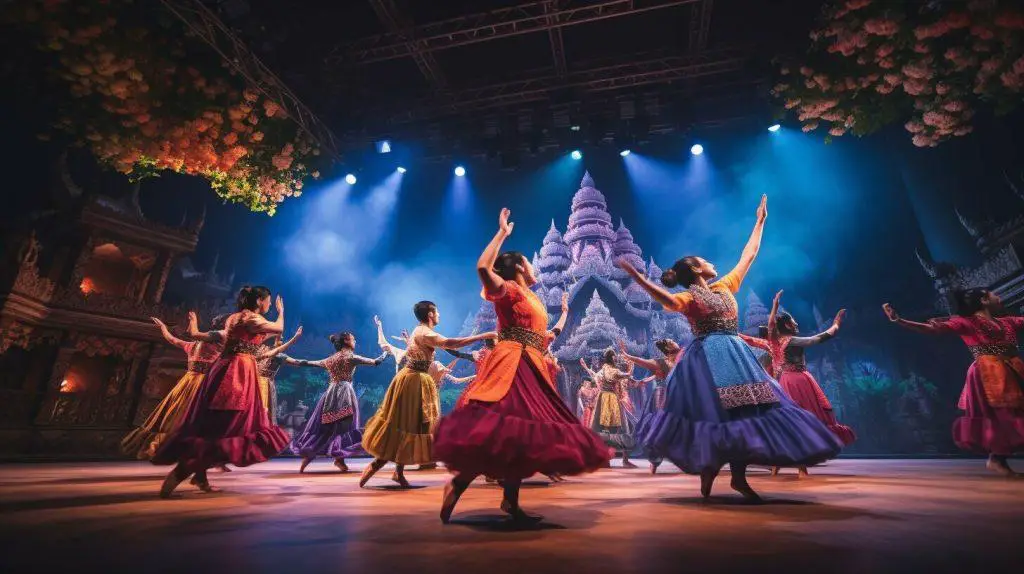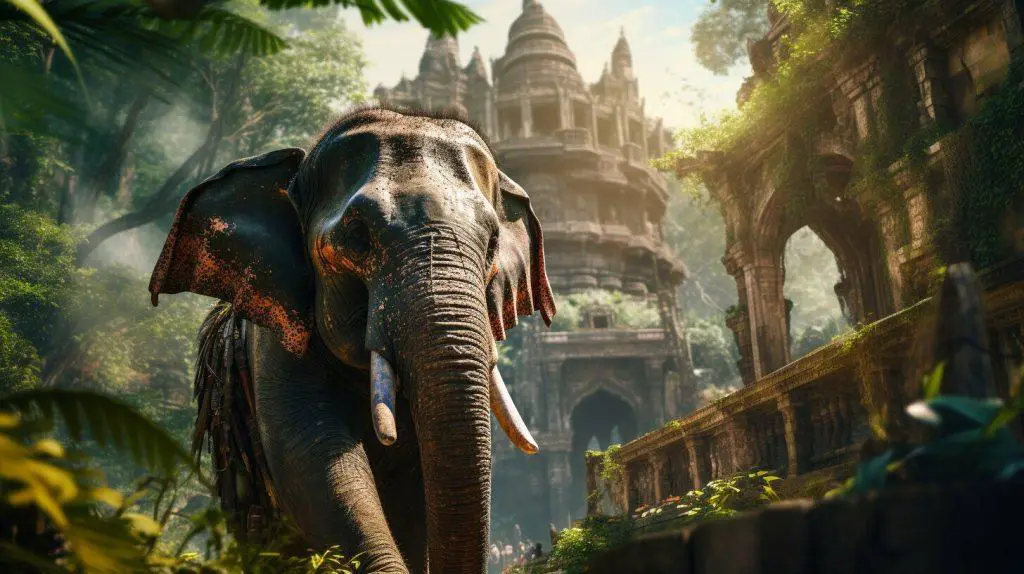Amongst the countless ancient temples encompassed within the sprawling Angkor complex in Cambodia, the Neak Pean Temple stands out for its unique and captivating qualities. Often overshadowed by its more famous counterparts, Neak Pean Temple remains a hidden gem waiting to be discovered.
Key Takeaways
- Neak Pean Temple is a hidden gem within the Angkor complex in Cambodia.
- The temple’s unique qualities make it stand out amongst other ancient temples.
- Neak Pean Temple is often overshadowed by its more popular counterparts.
History of Neak Pean Temple
Neak Pean Temple is a unique attraction in the vast complex of Angkor, a must-visit destination for travelers seeking to explore ancient Cambodian history. The temple’s historical significance is rooted in its construction during the 12th century under the reign of King Jayavarman VII.
Neak Pean Temple was dedicated to Buddha and served as a sanctuary for healing practices. Its architecture is inspired by the mythical Himalayan lake, Anavatapta, which is believed to have healing powers. Its name, Neak Pean, translates to “coiled serpents” and refers to the stone serpents that form the balustrade around the central pond.
Construction and Purpose
The temple’s central pond is the main attraction, featuring four small interconnected ponds that are believed to represent the four great rivers flowing from the Himalayas. The temple was designed to be a representation of Anavatapta, often depicted in Hindu and Buddhist mythology as being located at the center of the world.
Neak Pean Temple was built using sandstone and laterite, typical materials used in the construction of Angkor’s temples. The temple is surrounded by a moat, and the central pond can be accessed via a bridge. The purpose of the temple’s design was to symbolize the human body, with the water channels representing veins and the central pond as the heart.
Significance in Cambodian History
Neak Pean Temple represents a significant aspect of Cambodian history and is a testament to the ancient Khmer Empire’s artistic and architectural prowess. The temple is also an important symbol of the cultural and religious history of Cambodia, with its connection to Hindu and Buddhist mythology and healing practices.
Despite experiencing significant wear and tear over the centuries, the temple’s historical value has not diminished, and its restoration and preservation continue to be a priority for both locals and tourists alike.
Architectural Features of Neak Pean Temple
Neak Pean Temple is renowned for its unique architectural features that set it apart from other temples in the Angkor complex. Its most prominent feature is the central pond, which is surrounded by four smaller pools. In the middle of the pond is a circular structure that resembles a lotus flower, with eight serpent heads protruding from its base. The pond and surrounding water channels form a cruciform shape, with walkways leading to the central platform.
The design of Neak Pean Temple is rich in symbolism and reflects ancient Hindu and Buddhist beliefs. The central pond is believed to represent the mythical Himalayan lake Anavatapta, which is known for its healing properties. The serpents that surround the central structure symbolize the naga, a divine serpent in Hindu and Buddhist mythology that is associated with water and fertility.
Interconnected Water Channels
In addition to the central pond, Neak Pean Temple is also known for its intricate system of interconnected water channels. These channels link the four smaller pools to the central pond, creating a continuous flow of water throughout the temple. The channels are lined with sculptures of mythical animals such as lions, elephants, and nagas, which were believed to protect the temple from evil spirits.
| Architectural Feature | Symbolism |
|---|---|
| Central pond | Healing properties, representation of Himalayan lake Anavatapta |
| Serpent heads | Representation of the naga, divine serpent associated with water and fertility |
| Water channels | Continuous flow of water, protection from evil spirits through sculptures of mythical animals |
The interconnected water channels not only served a symbolic purpose but also had practical functions. They were designed to capture rainwater and channel it to the central pond, providing a reliable source of water for the temple’s inhabitants. The water also served a cooling function, helping to regulate the temperature in the temple during hot weather.
Mythology and Symbolism of Neak Pean Temple
The intricate design of Neak Pean Temple holds significant symbolism and mythology rooted in ancient Hindu and Buddhist beliefs. The central pond and interconnected water channels are symbolic of the sacred Himalayan mountain lakes believed to hold healing properties in Tibetan Buddhist tradition.
According to mythology, the temple represents the celestial Anavatapta Lake, known as the lake of the sun, which is believed to reside at the center of the universe. The four surrounding smaller ponds symbolize the four great rivers that flow from this central sacred lake in Hindu mythology: the Ganges, the Yamuna, theSarasvati, and the Godavari. The water flowing through the elaborate network of channels is believed to possess healing properties, and people would come from far and wide to bathe in its waters.
The temple’s intricate design holds significant symbolism and mythology rooted in ancient Hindu and Buddhist beliefs.
The temple’s architecture also has elements of Buddhism, such as a statue of Buddha on the central pedestal. The temple was believed to be a place of healing and was used for medicinal purposes, with the water from the surrounding pools used to treat various ailments. The temple would have been an important pilgrimage site for many people seeking healing and spiritual guidance.
The unique and intricate design of Neak Pean Temple makes it a significant cultural and historical landmark in Cambodia, preserving the country’s rich cultural and religious history for generations to come.
Restoration Efforts and Preservation of Neak Pean Temple
Neak Pean Temple, like many of the ancient structures in Angkor, has faced significant challenges over the years. Exposure to the elements, natural disasters, and human activity have all taken their toll on the temple’s delicate architecture. In recent years, restoration efforts have been undertaken to preserve this valuable cultural heritage site for future generations.
Current Restoration Efforts
The restoration of Neak Pean Temple is a complex and ongoing process that involves a team of experts and professionals. The restoration project is led by the APSARA National Authority, the governing body responsible for managing the Angkor Archaeological Park.
The restoration work involves a combination of research, documentation, and on-site reconstruction. Experts use a range of techniques and technologies including drone mapping, 3D scanning, and historical research to identify the original layout and features of the temple. Workers then use traditional materials and techniques to restore the temple to its former glory.
Currently, the restoration work focuses on reinforcing the temple’s structure, restoring the central tower, and repairing the intricate carvings and sculptures throughout the complex. The ultimate goal of the restoration efforts is to ensure that Neak Pean Temple remains a vital part of Cambodian history and culture.
Preservation Initiatives
Preservation initiatives are essential to protect Neak Pean Temple from further damage and degradation. The APSARA National Authority has implemented a range of measures to ensure the long-term preservation of the temple. These include:
- Regulating visitor access to the temple to prevent overcrowding and damage to the structures
- Monitoring the temple’s condition regularly to identify any signs of deterioration
- Implementing conservation strategies that take into account the environmental impact on the temple
- Working with local communities to raise awareness about the importance of cultural heritage preservation
Through these preservation efforts, Neak Pean Temple will continue to be preserved for future generations, providing a glimpse into Cambodia’s rich and fascinating history.
Visiting Neak Pean Temple: Practical Information
Neak Pean Temple is located in the Angkor Archaeological Park, approximately 12 km east of Siem Reap town center. To get there, visitors can either hire a tuk-tuk or a taxi for a round trip or rent a bicycle and ride to the temple on their own.
The Angkor Pass is required to enter the Angkor Archaeological Park, and it can be purchased at the ticket office located on the road to Angkor Wat. The pass prices are $37 for a one-day visit, $62 for a three-day visit, and $72 for a seven-day visit. The pass is non-transferable and must be presented at each site visited within the park.
Neak Pean Temple is open daily from 7:30 am to 5:30 pm, and visitors can access the temple via a wooden boardwalk across the central pond. The temple is relatively small compared to other Angkor sites, and visitors can expect to spend about 30-60 minutes exploring the grounds.
It is advisable to bring water, sunscreen, and insect repellent when visiting Neak Pean Temple, as there are no vendors or shops nearby. Visitors should also dress appropriately, covering their shoulders and knees out of respect for the local culture and religious sites.
If visitors plan to explore other sites within the Angkor complex, it is recommended to wear comfortable shoes and to plan their itinerary in advance to maximize their time.
Nearby Attractions in Angkor
Neak Pean Temple is just one of the many fascinating sites to visit within the Angkor complex. Here are a few other nearby attractions to consider adding to your itinerary:
- Preah Khan Temple: Built in the 12th century, Preah Khan Temple is a sprawling complex that was once a royal palace and Buddhist university. Visitors can explore its maze-like corridors, hidden courtyards, and stunning central sanctuary.
- Ta Som Temple: Another lesser-known gem, Ta Som Temple features a beautiful eastern entrance gate, as well as intricate carvings of Apsaras (celestial dancers) and other mythological figures.
- Banteay Srei Temple: Located about 30 km from the main Angkor complex, Banteay Srei Temple is known for its exquisite pink sandstone carvings, which feature intricate details and delicate shapes.
These are just a few of the many fascinating sites to explore in the Angkor area. Be sure to do your research and plan ahead, as there is much to see and experience in this unique and captivating part of the world.
Cultural Significance of Neak Pean Temple
Neak Pean Temple is an important cultural and historical landmark in Cambodia, representing the country’s rich religious and architectural heritage. The temple’s unique design and symbolism hold spiritual significance for Cambodians and visitors alike, making it an important part of the country’s cultural identity.
Constructed during the reign of King Jayavarman VII in the late 12th century, Neak Pean Temple was originally intended as a site for healing and spiritual cleansing. The temple’s interconnected water channels and central pond, representing the four great rivers of India, were believed to have therapeutic properties and were used in ancient healing practices.
Today, Neak Pean Temple continues to be an important site for spiritual and religious practices, with many locals and visitors coming to meditate or perform rituals at the temple. Its cultural significance extends beyond just its spiritual importance, however, as the temple also represents a unique example of Khmer architectural design and construction techniques.
As with many of Cambodia’s historical landmarks, Neak Pean Temple suffered damage and deterioration over time, particularly during the Khmer Rouge regime in the 1970s. However, ongoing restoration efforts have helped preserve the temple’s unique features and ensure its continued significance as a cultural icon.
For the people of Cambodia, Neak Pean Temple holds a special place in their hearts and represents the country’s cultural resilience and endurance in the face of adversity. Visitors to the temple can gain a deeper understanding and appreciation for Cambodia’s rich cultural history and the enduring importance of its spiritual and architectural heritage.
Neak Pean Temple: A Photographer’s Perspective
Neak Pean Temple is a breathtaking site that offers endless opportunities for photography enthusiasts. From its stunning architecture to its intricate details, there is much to capture here. Here are some tips to enhance your photography experience at Neak Pean Temple:
- Find unique angles: While the central pond may be the highlight of the temple, don’t forget to explore the surrounding areas for interesting perspectives. Experiment with different angles and compositions to capture the essence of the temple.
- Focus on the details: Neak Pean Temple is rich in detail and symbolism. Look for intricate carvings and patterns on the temple walls, and focus on capturing the smaller, lesser-known details that make this temple unique.
- Play with light: The temple’s location and design offer a range of lighting options throughout the day. Experiment with different lighting conditions to capture the temple’s beauty in a new way.
- Use the reflections: The central pond is not only a beautiful feature of the temple but also offers the opportunity for stunning reflections. Play with the reflections to create unique and striking images.
- Be respectful: When taking photos at Neak Pean Temple, it’s important to be respectful of the site and its history. Avoid climbing or touching the temple, and be mindful of the local culture and customs.
With its stunning beauty and cultural significance, Neak Pean Temple is a photographer’s dream. By taking the time to explore the temple and experiment with different techniques, you’re sure to capture some truly stunning images.
Conclusion
Neak Pean Temple is truly a hidden gem within the Angkor complex, offering a unique blend of history, art, and spirituality. From its intriguing architecture to its rich mythology, the temple has much to offer to both locals and visitors alike. It also plays a significant role in Cambodia’s cultural heritage, reminding us of the country’s rich past and inspiring us to preserve its legacy for future generations.
If you’re planning a trip to Angkor, Neak Pean Temple is a must-see attraction that should not be missed. With its serene atmosphere and stunning beauty, the temple offers a perfect escape from the hustle and bustle of modern life. So pack your bags, grab your camera, and get ready to explore this incredible piece of Cambodian history!
FAQ
What is the history of Neak Pean Temple?
Neak Pean Temple has a rich historical background, believed to have been constructed in the late 12th century. It served as a sacred site for religious rituals and healing practices in ancient Cambodia.
What are the architectural features of Neak Pean Temple?
Neak Pean Temple is known for its unique architectural design, featuring a central pond surrounded by four interconnected water channels. The temple’s structure showcases intricate carvings and symbolic elements.
What is the mythology and symbolism associated with Neak Pean Temple?
Neak Pean Temple holds significant mythical and symbolic meaning, rooted in ancient Hindu and Buddhist beliefs. It is believed to represent a cosmic mandala and was associated with water deities and healing rituals.
Are there any restoration efforts and preservation initiatives for Neak Pean Temple?
Yes, there are ongoing restoration and preservation initiatives aimed at safeguarding Neak Pean Temple’s historical and cultural value. These efforts ensure the temple’s longevity and accessibility for future generations.
What practical information should I know before visiting Neak Pean Temple?
When planning your visit to Neak Pean Temple, consider aspects such as ticket prices, opening hours, location, and transportation options. Doing so will help you make the most of your experience at the temple.
What are some nearby attractions in Angkor that I can explore?
Alongside Neak Pean Temple, there are several other notable attractions within the Angkor complex. Consider visiting places like Ta Prohm, Bayon Temple, and Angkor Wat to enhance your Angkor experience.
What is the cultural significance of Neak Pean Temple?
Neak Pean Temple holds immense cultural significance in Cambodia’s history and heritage. It serves as a symbolic representation of the country’s ancient beliefs and plays a vital role in the local community.
Can you provide tips for photography at Neak Pean Temple?
Absolutely! To capture the beauty of Neak Pean Temple, consider experimenting with different angles, utilizing natural lighting, and focusing on the intricate details. These techniques will enhance your photography experience.



